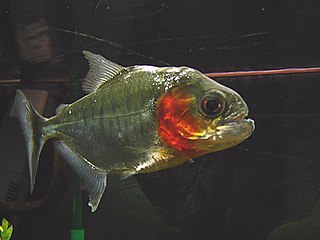
Serrasalmus is a genus of piranhas. They are collectively known as pirambebas; the "typical" piranhas like the piraya piranha are nowadays placed in Pygocentrus. Like all piranhas, Serrasalmus are native to South America.

Aequidens is a genus of fish in the family Cichlidae found in South America. Formerly a wastebasket genus, as presently defined Aequidens is largely restricted to the Amazon Basin, Orinoco Basin and river basins in The Guianas. The only exceptions are A. plagiozonatus which also occurs in the Paraná Basin, and A. tetramerus which also occurs in the Parnaíba River.
Harttia is a genus of armored catfishes native to South America.

Pristobrycon is a genus of piranhas from the Orinoco and Amazon Basins, as well as rivers in the Guianas.

Bryconops is a genus of freshwater fish in the family Iguanodectidae from South America. It consists of small fish, all under half-a-foot long, with slender bodies and silvery scales, though there is some mild color variation. Several species can be identified by way of a humeral patch, and others have a reddish ocellus, or eyespot, on one or both lobes of the dorsal fin.

Aphyocharax is a genus of characins from South America, specifically the Amazon, Orinoco, Essequibo, Paraguay and Paraná basins. The 11 currently described species in this genus are:

Creagrutus is a genus of characins found mostly in South America, with one species C. affinis extending into Panama in Central America.
Knodus is a genus of characins, small freshwater fish from South America.

Apareiodon is a genus of scrapetooths from South America where they are found as far south as Río de la Plata. There are currently fifteen described species in this genus.

Iguanodectidae is a family of freshwater fish in the order Characiformes that lives in South America. It is home to the subfamily Iguanodectinae and the monotypic Bryconops clade. Several species in the family, such as the green line lizard tetra, the tailspot tetra, and the orangefin tetra, are sometimes taken as aquarium fish.

The orangefin tetra is a small species of freshwater fish from South America that belongs to the family Iguanodectidae. Though common in its native range, it seems to prefer fast-flowing and shallow creeks. It is an active swimmer that feeds on plant material and various invertebrates, sometimes jumping out of the water to catch prey above the surface.

Bryconops alburnoides is a small freshwater fish, approximately 6 inches long at its largest, that lives in the rivers of South America. It has a slender body, with a yellowish dorsal fin and yellow-tinged back scales that fade into silver on its belly. It is largely an insectivore that picks land-dwelling insects from the riverbanks, though it eats much more whenever rain washes prey into the water.

The tailspot tetra is a freshwater fish that lives in the coastal river regions of upper South America. Both its common and scientific names reference the distinct spot of color present on the tail fin, which is one of its defining characteristics. It is a small fish, reaching 4.8 in at its longest. Despite its small size, it is an active swimmer, with a preference for fast-flowing waters.

Bryconops collettei is a small freshwater fish from the rivers of South America. It is mostly silvery, with notable green iridescence on its sides, and a diffuse ocellus (eyespot) on the upper lobe of the caudal fin. Before its distinction as a separate species, specimens of B. collettei were misidentified as specimens of Bryconops caudomaculatus due to several morphological similarities, including a caudal ocellus and generally similar fin coloration.
Bryconops disruptus is a small freshwater fish of the family Iguanodectidae. It is only found in the Rio Negro in South America. Like the rest of the genus Bryconops, B. disruptus is silvery in color, with a relatively deep chest and a notable set of teeth. The specific epithet "disruptus" refers to the incomplete lateral line.
Bryconops durbinae, sometimes listed under the name Bryconops durbini, is a small species of freshwater fish in the family Iguanodectidae. It is the smallest species of the genus Bryconops. Like all members of Iguanodectidae, it inhabits rivers in the upper half of South America.

Bryconops giacopinii is a mid-sized species of freshwater fish in the family Iguanodectidae. It is the largest member of the genus Bryconops, and is therefore difficult to confuse with any of its congeners. With a diet that consists largely of land-dwelling insects, it serves as an important link between the terrestrial and aquatic aspects of its native range.
Bryconops humeralis is a small freshwater fish distributed across northern South America. The name "humeralis" means "relating to the shoulder", in reference to the distinct humeral patches that the fish sports. It is slightly longer than average in terms of the genus Bryconops, though still firmly within the standard range, and is slightly more slender than is usual for its congeners.
Bryconops inpai is a small freshwater fish native to the rivers of South America. It only lives in two particular river systems - the Casiquiare and Negro - which means that its range is restricted to the northern half of the continent. It has indistinct humeral spots, and is bluish-silver in life, which is unusual for members of Bryconops; they are more often plain silver or greenish-silver.
Bryconops vibex is a small freshwater fish from the rivers of Venezuela, known solely from the Rio Cataniapo. The body is slender, though with an element of sturdiness, and it has one humeral spot by each pectoral fin. It bears visual similarities to several congeners, but can be differentiated by way of many factors.










